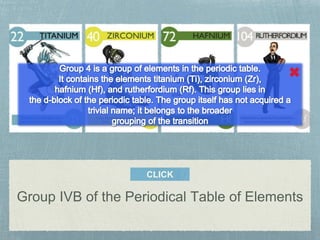
Group IV-B elements
- 1. CLICK Group IVB of the Periodical Table of Elements
- 2. Discovered independently by William Gregor and Martin Klaproth in 1795, titanium (named for the mythological Greek Titans) was first isolated in 1910. It is a highly corrosion-resistant metal with great tensile strength. It is ninth in abundance for elements in the earth's crust. Titanium is used for strengthening structural materials but is also useful in strengthening bones in the human body where it is used to make durable repairs since it does not react with tissue. Most titanium metal is refined from a mineral known as rutile, TiO2. This is an intensely white powder that is also used as a high-hide paint pigment.
- 3. Some Uses Titanium is important as an alloying agent with aluminum, molybdenum, manganese, iron, and other metals. Alloys of titanium are principally used for aircraft and missiles where lightweight strength and ability to withstand extremes of temperature are important. Titanium is as strong as steel, but 45% lighter. It is 60% heavier than aluminum, but twice as strong. Titanium dioxide is extensively used for both house paint and artist's paint, because it is permanent and has good covering power. Titanium oxide pigment accounts for the largest use of the element. Titanium paint is an excellent reflector of infrared, and is extensively used in solar observatories where heat causes poor viewing conditions.
- 4. Zirconium is a greyish-white lustrous metal. The finely divided metal can ignite spontaneously in air, especially at elevated temperatures. The solid metal is much more difficult to ignite. The inherent toxicity of zirconium compounds is low. Hafnium is invariably found in zirconium ores, and the separation is difficult. Commercial grade zirconium contains from 1 to 3% hafnium. The hafnium is removed from the zirconium used in the nuclear power industry. Zirconium is found in S-type stars, and has been identified in the sun and meteorites. Analyses of lunar rock samples show a surprisingly high zirconium oxide content as compared with terrestrial rocks. Some forms of zircon (ZrSiO4) have excellent gemstone qualities.
- 5. Uses It is used extensively by the chemical industry where corrosive agents are employed. Zirconium is used as a getter in vacuum tubes, as an alloying agent in steel, in surgical appliances, photoflash bulbs, explosive primers, rayon spinnerets, lamp filaments, etc. It is used in poison ivy lotions in the form of the carbonate as it combines with urushiol. With niobium, zirconium is superconductive at low temperatures and is used to make superconductive magnets, which offer hope of direct large-scale generation of electric power. Zirconium oxide (zircon) has a high index of refraction and is used as a gem material. The impure oxide, zirconia, is used for laboratory crucibles that will withstand heat shock, for linings of metallurgical furnaces, and by the glass and ceramic industries as a refractory material. Its use as a refractory material accounts for a large share of all zirconium consumed.
- 6. Most zirconium minerals contain 1 to 3% hafnium. Hafnium is a ductile metal with a brilliant silver lustre. Its properties are influenced considerably by the impurities of zirconium present. Of all the elements, zirconium and hafnium are two of the most difficult to separate. Hafnium is a Group 4 transition element. Because hafnium has a good absorption cross section for thermal neutrons (almost 600 times that of zirconium), has excellent mechanical properties, and is extremely corrosion resistant, it is used for nuclear reactor control rods. Hafnium carbide is the most refractory binary composition known, and the nitride is the most refractory metal nitride (m.p. 3310°C).
- 7. Uses Because the element not only has a good absorption cross section for thermal neutrons (almost 600 times that of zirconium), but also excellent mechanical properties and is extremely corrosion- resistant, hafnium is used for reactor control rods. Such rods are used in nuclear submarines. Hafnium is used in gas-filled and incandescent lamps, and is an efficient getter for scavenging oxygen and nitrogen.
- 8. In 1964 researchers in the Soviet Union at Dubna announced their discovery of element 104. A similar claim was made by researchers at the University of California at Berkeley. The Soviet scientists claimed to have bombarded a target of Pu-242 with Ne-22, resulting in a nucleus with 104 protons and a mass number of 260. The Berkeley team used a Cf-249 target and isotopes of carbon for projectiles, resulting in isotopes of 104 with mass numbers of 257 and 259. Several other isotopes were also prepared by the American team. The naming and priority of discovery controversy has raged ever since and Rutherfordium is the approved name selected by the IUPAC in August 1997.
- 9. Rutherfordium is a synthetic element that is not present in the environment at all. It has no uses.
